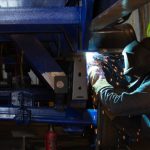 The process of commercial steel fabrication is a complex and precise craft that involves several stages, from initial design to final installation. It is a highly specialized field that requires skilled professionals and cutting-edge technology to ensure the creation of high-quality structures. In this blog post, we will delve into the different stages of the commercial steel fabrication process, highlighting the intricate steps involved in crafting excellence.
The process of commercial steel fabrication is a complex and precise craft that involves several stages, from initial design to final installation. It is a highly specialized field that requires skilled professionals and cutting-edge technology to ensure the creation of high-quality structures. In this blog post, we will delve into the different stages of the commercial steel fabrication process, highlighting the intricate steps involved in crafting excellence.
1. Design and Planning
The initial stage of the commercial steel fabrication process begins with meticulous design and planning. Architects, engineers, and fabricators work closely together to create comprehensive design drawings and specifications. These plans take into account the intended purpose of the structure, as well as factors such as load-bearing requirements, environmental conditions, and aesthetic considerations. During this stage, computer-aided design (CAD) software is often utilized to create detailed 3D models, ensuring accuracy and facilitating communication between all parties involved.
2. Material Procurement
Once the design is finalized, the next step in the fabrication process is the procurement of the necessary materials. High-quality steel is a vital component in commercial steel fabrication, as it provides strength, durability, and corrosion resistance. Fabricators typically work closely with suppliers to source the required steel in various forms, such as beams, plates, and tubes. The steel is then carefully inspected to ensure it meets stringent quality standards before it is used in the fabrication process.
3. Cutting and Shaping
After the materials are obtained, the fabrication process moves to cutting and shaping the steel. Advanced machinery, such as CNC (Computer Numerical Control) cutting equipment, is used to precisely cut the steel to the required dimensions. This ensures accuracy and reduces material waste. Additionally, various techniques, such as shearing, punching, and drilling, are employed to shape the steel into the desired components and elements of the structure. Skilled fabricators meticulously follow the design plans to ensure each piece is crafted with precision.
4. Welding and Joining
Welding and joining are fundamental steps in the commercial steel fabrication process. Skilled welders utilize specialized techniques, such as arc welding or gas metal arc welding, to permanently join the steel components. This creates robust and structurally sound connections that can withstand immense forces. Welders also conduct thorough inspections to ensure the quality and strength of the welds, adhering to industry standards and specifications.
5. Surface Treatment and Finishing
To enhance the integrity and appearance of the fabricated steel components, surface treatment and finishing processes are applied. This involves procedures such as abrasive blasting, which removes impurities and creates a clean surface for coating. Various protective coatings, such as paint, epoxy, or galvanizing, are then applied to prevent corrosion, improve aesthetics, and enhance durability. These treatments not only provide a professional finish but also extend the lifespan of the fabricated steel structures.
6. Quality Control and Inspection
Throughout the commercial steel fabrication process, strict quality control measures are implemented to ensure that every step meets the highest standards. Skilled inspectors closely monitor the fabrication process, conducting frequent inspections and tests to ensure compliance with industry codes and regulations. This includes evaluating the accuracy of measurements, verifying the quality of welds, and performing non-destructive testing, such as ultrasonic or magnetic particle testing, to detect any defects or inconsistencies.
7. Transportation and Installation
Once the fabrication process is complete, the final stage involves carefully transporting the fabricated steel components to the construction site for installation. Experienced rigging and transportation teams employ specialized equipment, such as cranes and flatbed trucks, to handle and transport the hefty steel structures safely. These teams work closely with construction crews to ensure smooth and efficient installation, aligning each component accurately according to the design plans.
Summary
The commercial steel fabrication process is a meticulous and intricate craft that involves several stages, from initial design to final installation. The collaborative efforts of designers, fabricators, welders, and inspection teams are crucial for crafting excellence in commercial steel structures. By following a precise and carefully executed process, steel fabricators create structures that are not only visually striking but also built to withstand the test of time. Whether it’s a high-rise building, a bridge, or an industrial facility, commercial steel fabrication plays a pivotal role in constructing robust and durable structures that shape our modern world.
Need a Steel Fabricator & Welding Shop In Visalia, CA?
Suburban Pipe & Steel, Inc. DBA Flint Construction. in Visalia, California, doing business as Flint Construction, has been family owned since 1957. We truly understand steel buildings. We design, fabricate, and install all phases of pipe and steel structures for every industry. Contact us today to find out more about our services, rates, and to schedule a consultation. You can even fax us your drawings so we can have a better idea of your vision. We look forward to exceeding your expectations.
